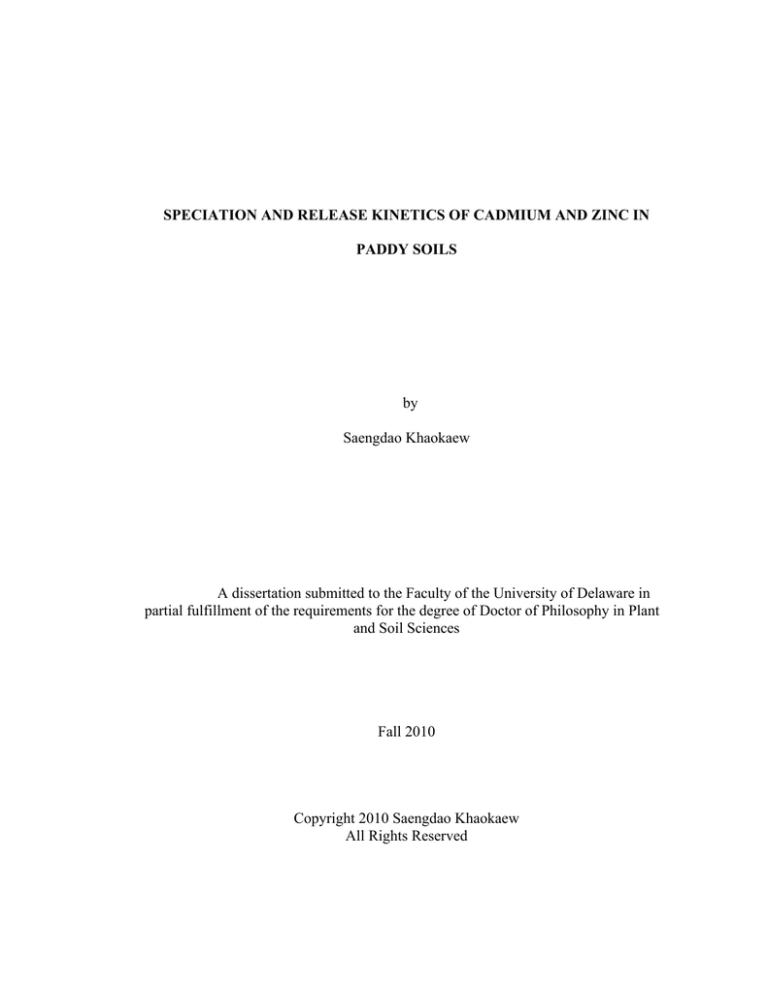
SPECIATION AND RELEASE KINETICS OF CADMIUM AND ZINC IN
PADDY SOILS
by
Saengdao Khaokaew
A dissertation submitted to the Faculty of the University of Delaware in
partial fulfillment of the requirements for the degree of Doctor of Philosophy in Plant
and Soil Sciences
Fall 2010
Copyright 2010 Saengdao Khaokaew
All Rights Reserved
ABSTRACT
Cadmium contamination in paddy soils of rice-producing countries has
been reported at many locations near Zn mining and smelting plants. Cadmium in
these soils can contaminate rice and subsequently enter the human food chain. Longterm Cd consumption causes chronic Itai-itai disease, which is characterized by renal
proximal tubular dysfunction and osteomalacia. Understanding the chemical forms in
which Cd and Zn are present in paddy soils is needed to develop efficient and costeffective strategies to clean up the soils, and/or minimize Cd uptake by rice.
Knowledge of metal speciation is essential because it directly controls metal mobility
and bioavailability. The main goals of this study are to investigate Cd and Zn
speciation and release kinetics in a paddy soil contaminated by Cd and Zn, obtained
from the Mae Sot district, Tak province, Thailand. This study was conducted with a
soil untreated (referred as the alkaline soil), or acidified to pH 6 and spiked with
K2SO4 (referred as the acidified soil). These two soil samples were studied under
various flooding periods and draining conditions, to mimic lowland rice culture. The
secondary goal of this study is to identify the predominant low molecular weight
organic acids (LMWOAs) excreted from two Thai rice cultivar under Cd stress, and to
elucidate the effect of these LMWOAs on Cd and Zn desorption in the paddy soils.
Synchrotron-based techniques, including bulk x-ray absorption fine structure (bulkXAFS) spectroscopy, micro x-ray fluorescence (!-XRF) spectroscopy, and micro xray absorption near-edge structure (!-XANES) spectroscopy, and a stirred-flow
xiv
kinetic method were employed to elucidate Cd and Zn speciation, metal
distribution/association, as well as Cd and Zn release kinetics, respectively.
Results from the alkaline soil revealed that, under all flooding and
draining conditions, less than 25% of Cd was released during 2 hours of desorption
using the strong chelating agent, DTPA-TEA-Ca. Bulk-XAFS analysis revealed that
Cd carbonates were the most important species in the alkaline soil. Cadmium
associated with humic acid was found in the air-dried soil and after 1 day of flooding.
However, this species was not detected after 30 days of flooding. Small amounts of
CdS were present after 30 days of flooding, and persisted over 150 days of flooding.
Other species, e.g. Cd-kaolinite and Cd-ferrihydrite, were found after short periods of
flooding, but were no longer significant after 150 days of flooding.
In the acidified soil, Cd sorbed to kaolinite was the dominant species after
flooding, and its amount increased with increasing flooding periods. Cadmium sorbed
to humic acid was found in the acid air-dried soil, spiked with K2SO4, and its amount
increased after flooding. However, this species was not detected after 150 days of
flooding. Flooding conditions did not cause the acidified soil to become as highly
reducing as expected, which more likely due to high soluble nitrate or salinity in the
acidified soil. During 2 hours of desorption using the strong chelating agent, DTPATEA-Ca, cumulative Cd desorption reached 100% under air-dried soil conditions, and
greater than 50%, at all flooding periods and draining conditions. The !-XRF maps
showed that there was no association between Cd and Zn.
The study on Zn speciation and release kinetics showed that almost no
change occurred in Zn speciation and release kinetics in the soils due to flooding or
acidification, although the alkaline and acidic soils were subjected to different
xv
flooding periods, and drained to field capacity or saturation. After 2 hours of stirredflow experiment using the strong chelating agent, DTPA-TEA-Ca, the cumulative Zn
desorption was less than 25% in all soil samples. Only two main phases were
identified by LLSF, i.e. Zn-layered double hydroxides (Zn/Mg-hydrotalcite-like, and
ZnAl-LDH) and Zn-phyllosilicates (Zn-kerolite). Micro-XRF maps showed that Zn
was localized and associated with Cu in most samples.
The in vitro study on root exudates from two local Thai rice cultivars
(jasmine and glutinous) under Cd stress revealed that the pH in the rhizosphere was
not dependent on Cd concentration, but decreased when roots of each rice cultivar
were introduced into the media. Additionally, the types and concentrations of
LMWOAs secreted by the two rice cultivars were not dependent on Cd concentration.
Both rice cultivars secreted three main LMWOAs, in the following order: oxalic >
citric > maleic acids. The amounts of Cd and Zn released were dependent on the types
and concentrations of the organic acids, and soil pH. Citric acid showed the greatest
ability to desorb Cd and Zn from soil components.
xvi





